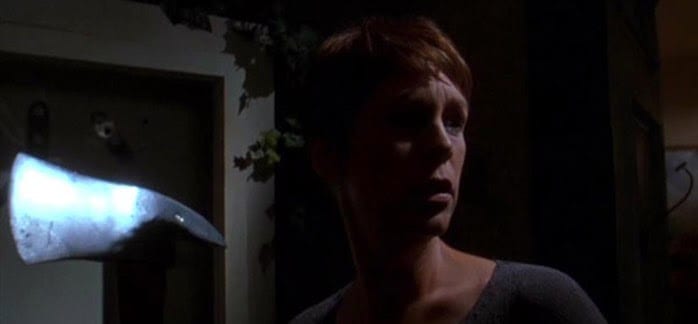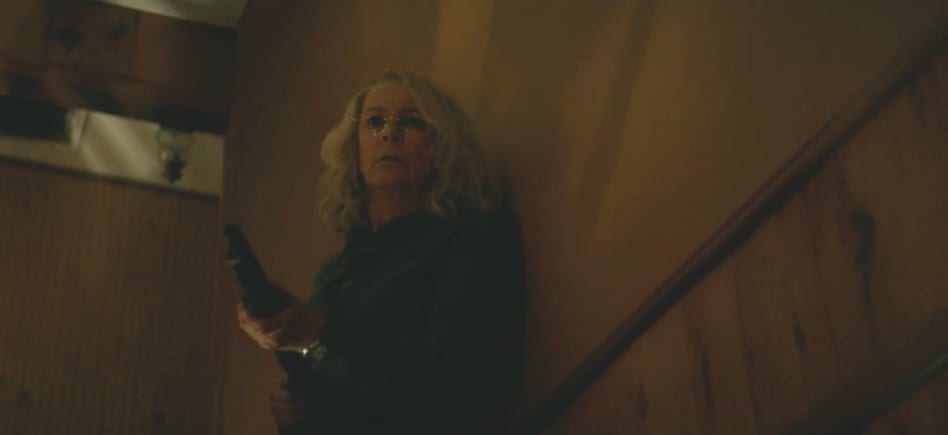Sadly, I’ve always taken John Carpenter’s Halloween for granted. The midwestern Hitchcock-esque thrills of the 1978 film did not impress me as much as Prince of Darkness: a bonkers tribute to surreal Italian horror with a premise that melds scientific intrigue and supernatural horror.
However, this all changed last year when I saw Carpenter’s film on the big screen (quite fittingly on Halloween). There’s a scene near the end where the protagonist, Laurie Strode (Jamie Lee Curtis), attempts to console and instruct the two kids (Tommy and Lindsay) she’s babysitting (while being pursued by Michael Myers). The scene moved me to tears and finally made me realize why the film is so resonating.
Halloween is one of the most primal horror films. Through its characters, it paints a canvas for our most ingrained fears and traits to be laid bare. The first character of note is Michael Myers. On the surface, the central slasher can be interpreted as a purely amorphous creation (given his credit as The Shape and the lack of backstory). However, this is only telling half of the story.
Myers taps into a childhood fear of the monster under the bed being real. There’s persistent lip service in the film given to the bogeyman and the fact that he exists for a lot of the kids. In the film’s most chilling moments, Myers becomes a stand-in for the bogeyman. One particularly memorable instance is when Tommy is looking out of the window and sees Myers carrying a body into a neighboring house. He says to Laurie that he’s seen the bogeyman. However, like a ghost, Myers is gone by the time Tommy’s babysitter looks outside. By the end, Laurie, and Myers’s therapist, Dr. Samual Loomis (Donald Pleasence), raise the character to this mythical bogeyman status, with the following dialogue exchange:
Laurie: Was that the bogeyman?
Dr. Sam Loomis: As a matter of fact, it was.

Like Myers, Laurie Strode is often interpreted in a particular way. The postmodern horror trend of the 90s (best encapsulated in Scream) painted the character in which her virgin status allows her to live. This has snowballed into a general cliche that has permeated the genre.
However, Laurie’s perceptiveness is an invaluable quality that keeps her alive. Throughout the film, this manifests in small ways, such as noticing that someone is following her group of friends. Or when she clocks Annie’s Dad (Sheriff Brackett) while she’s sharing a joint. At the same time, Laurie’s kindness and empathy are pivotal for her character. Unlike her friends, she does not shirk off her babysitting responsibilities but instead embraces them and attempts to have a good relationship with Tommy.
The original title for Halloween was The Babysitter Murders. That title has resonance in relation to Laurie. With a combination of perceptiveness, empathy, and kindness, the entire ordeal is an awakening for Laurie’s maternal instincts. Throughout the film, these qualities are almost fleeting and exist beneath the surface for the character. But in the most charged scenes where she consoles Tommy and Lindsay, they come to the fore like a switch that’s been flipped.
This aspect becomes quite potent because of John Carpenter and Debra Hill’s choice to limit the number of adults in the film. Aside from Laurie’s teacher, Sheriff Brackett, and Loomis, they exist as nonentities. With this in mind, Halloween can be interpreted as a primal tale of a character finding strength by unlocking a side of herself in the midst of an attack on her home and children.
But as everyone knows, the fable of Laurie’s maternal instincts does not end here. Some of the sequels tug on this thread by showing Laurie as a mature woman and an actual mother.

In 1998, the Halloween franchise got its first reboot with Halloween H20: 20 Years Later. Taking place two decades after the events of Halloween II (1981), the film depicts Laurie’s continual struggle with her trauma in the midst of Myers’s return to her hometown.
Laurie Strode (now named Keri Tate) faked her death and now resides in California, working as a headmistress at a private boarding school. Strode is still haunted by her encounters with Myers. She regularly has nightmares that have the events of Halloween spill into her everyday life. She’s also on extensive medication and is at her wit’s end in coping with the trauma. This is even becoming problematic to her 17-year old son, John, who seeks independence.
As a reaction to the events of the original Halloween, H20 is fascinating. Aside from being afraid of Myers’s return, Laurie’s neurosis could be read as an inherent fear of that primal side she tapped into. In a sense, she caught a glimpse at a side of herself that scared her into shedding her identity. As much as the film is a depiction of a woman dealing with PTSD, it’s also a reforging of her identity. It’s no mistake that after confessing her past,
Laurie’s primal instincts kick in and never let up until Myers is dead.

The latest entry in the Halloween franchise came out in 2018. The reboot takes place 40 years after the events of the 1978 film. In this incarnation, Laurie is an overbearing and ultra-paranoid elderly woman who lies in wait for Myers’s return. This is in stark contrast to her daughter (Karan) and granddaughter (Allyson) who are attempting to build a normal life.
If H20 was a portrait of a woman who has repressed her primal instincts, Halloween (2018) is an illustration of a woman whose need to protect and survive never left. The events in Halloween triggered something in Laurie. It’s as though she witnessed a great affront to nature, and now feels she has to dedicate her entire life to preparing for its return. In this way, Laurie has become like Dr. Loomis, who was convinced that Myers was the epitome of evil.
The choice of Loomis’s voice cameo saying “It needs to die!” juxtaposed with Laurie fingering a gun while waiting for Michael to be released, illustrates this well. At the same time, the notion of Myers being the bogeyman in Halloween is also referenced by Laurie. At the end of the 1978 film, she asks if Myers is the bogeyman? When addressing two true crime podcasters, she simply says:
You don’t believe in the bogeyman? You should!
There’s also a sense in Halloween (2018) that Laurie’s experience with Michael has transformed her into a monster. There are purposeful callbacks where Laurie is placed in the precise spots where Myers was in the first film. It’s as though the character has become like the bogeyman: an almost supernatural figure who now haunts the family she caused so much pain to.
Laurie extensively trained her daughter to prepare for Myers’s resurgence. This included learning to use a gun, fight, and being proficient in the use of a weaponized basement. This led to Karen being taken by social services when she was 12-years old.
With this in mind, the fairytale-esque tale of Laurie’s maternal instincts awakening in Halloween (1978) takes on a starker reading. This gives way to a reading of some essence of Myers being transferred into Laurie.
From Myers tapping into primal childhood fears to some of the various interpretations of Laurie’s instincts in the franchise: the Halloween series explores some primal themes with a psychological depth that remains unsurpassed in the slasher genre.


